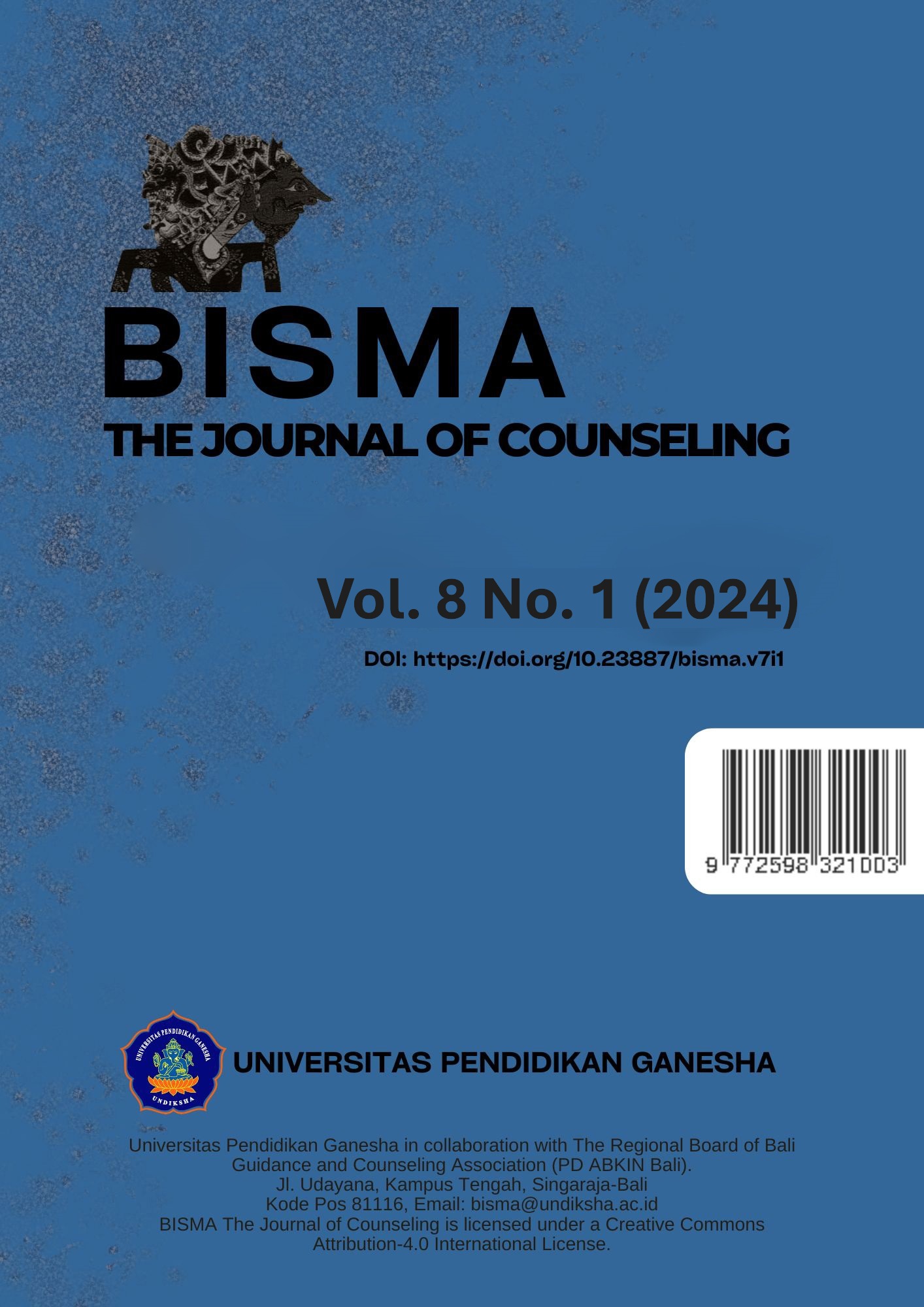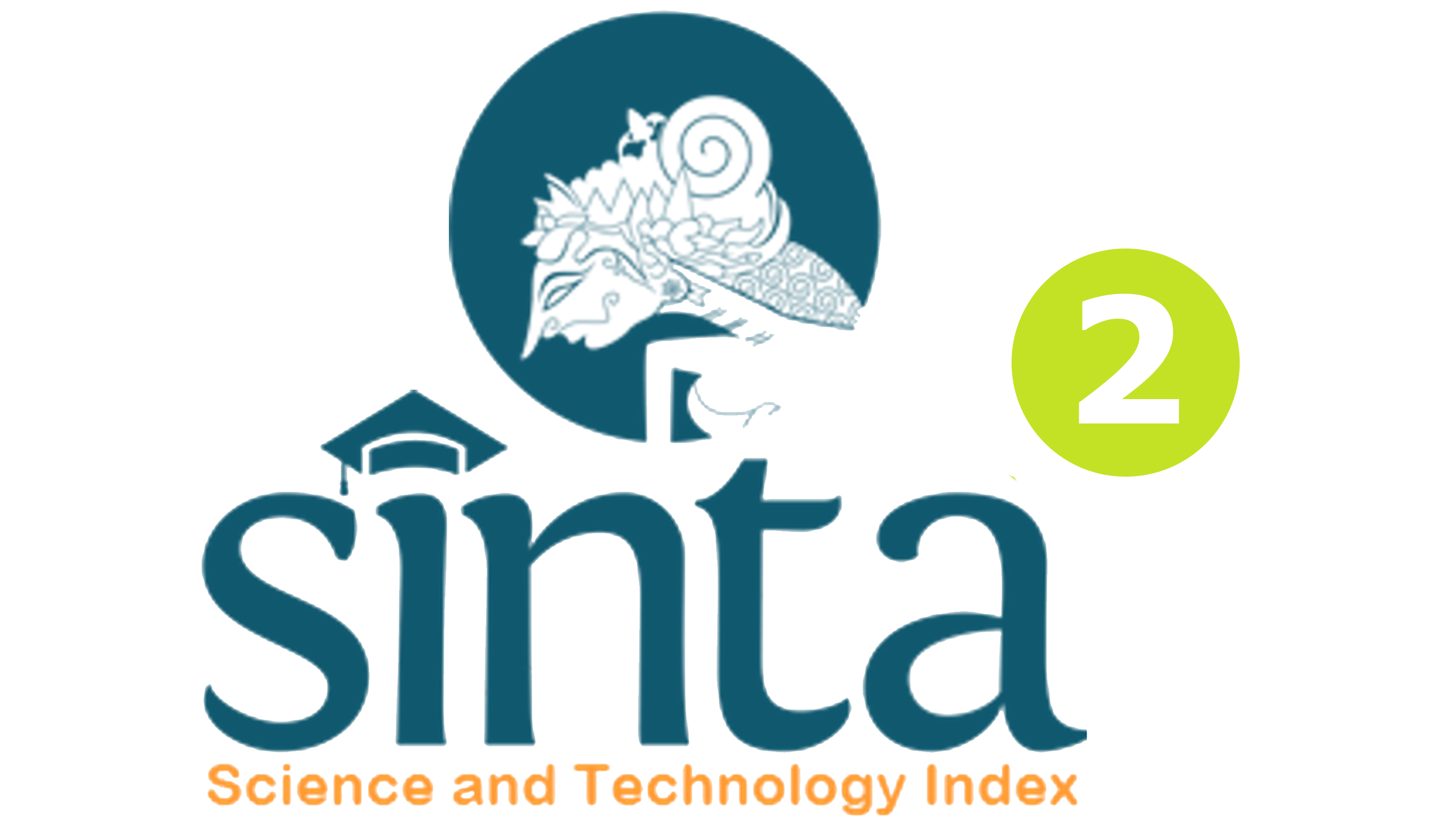Trust and Quality of Communication with the Marriage Commitment of TNI AU Undergoing Long Distance Marriage
DOI:
https://doi.org/10.23887/bisma.v8i1.84279Keywords:
Trust, Communication Quality, Long Distance Marriage CommitmentAbstract
Couples who are in a long-distance marriage need a strong commitment to maintain their marriage. Challenges that often arise include feelings of anxiety, partner support, sharing of time, the temptation of infidelity, and the role of raising children. Trust, as confidence and concern for a partner, as well as good communication quality, are important factors that influence marital commitment in this situation. This research aims to analyze the relationship of trust and Communication quality and long distance marriage commitment. This research uses a quantitative descriptive approach with correlational quantitative methods. The research populations are totaling 60 pairs and a sample of 44 pairs. Sampling used purposive sampling technique. Data analysis is using descriptive statistical techniques, and then using multiple regression analysis. The findings of this research are: 1) the trust of married couples undergoing long distance marriages is in the high category at 48.86% (R2 = 0.632), 2) the communication quality of married couples undergoing long distance marriages is in the high category at 50.00% (R2 = 0.723), 3) the marital commitment of husband and wife couples undergoing long distance marriage is in the very high category at 56.82%, 4) there is a significant relationship between trust and quality of communication with the Indonesian Air Force's long distance marriage commitment through the test The significance of the correlation coefficient is R Square = 0.757 with a very strong level of correlation.
References
Afiatin, T., Istianda, I. P., & Wintoro, A. Y. (2016). Happiness of Working Mothers Through Family Life Stages. ANIMA Indonesian Psychological Journal, 31(3), 101–110. https://doi.org/10.24123/aipj.v31i3.569.
Alawamleh, M., Al-Twait, L. M., & Al-Saht, G. R. (2022). The effect of online learning on communication between instructors and students during Covid-19 pandemic. Asian Education and Development Studies, 11(2), 380–400. https://doi.org/10.1108/AEDS-06-2020-0131.
Amini, M., Amini, Y., & Hosseinian, S. (2013). Efficacy of couples communication skills group training using interaction analysis approach (TA) on reducing marital conflicts. Family Counseling and Psychotherapy, 3(3), 377–401. https://fcp.uok.ac.ir/m/article_9632.html?lang=en.
Andika, M. F. F. (2022). Value of Social Care Character Through Education and Community Activities. Journal of Innovation in Educational and Cultural Research, 3(3), 311–315. https://doi.org/10.46843/jiecr.v3i3.76.
Anyamene, A. (2020). Relationship between demographic factors, Emotional Intelligence and Marital Satisfaction of Male and Female Married Teachers in Anambra State. European Journal of Educational Sciences, 6(3), 1–16. https://www.ceeol.com/search/article-detail?id=907705.
Aqmarina Bella Agustin. (2019). Javanese Muslim Local Culture And Tradition In Islamic Perspective. Sunan Kalijaga International Journal on Islamic Educational Research (SKIJIER), 3(1), 15–24. https://doi.org/10.14421/skijier.2019.2019.31.02.
Arulmohi, M., Vinayagamoorthy, V., & R., D. A. (2017). Physical Violence Against Doctors: A Content Analysis from Online Indian Newspapers. Indian Journal of Community Medicine, 42(1), 147–150. https://doi.org/10.4103/ijcm.IJCM.
Askalemariam, A., & Minwagaw, T. (2014). Divorce in east Gojjam zone: rates, causes and consequences woodpecker. Journal of Sociology and Anthropology, 2(1), 008–016. https://www.tandfonline.com/doi/abs/10.1080/23311908.2021.1903127.
Axelfa, A., Aprilia, T., Wibawa, A., & Suharti, B. (2024). Komunikasi Intrapersonal (Self-Talk) Dalam Meningkatkan Kesadaran Dampak Buruk Self-Harm Pada Remaja Brokenhome. Jurnal Communio : Jurnal Ilmu Komunikasi, 13(1), 29–43. https://doi.org/10.35508/jikom.v13i1.9284.
Charina, A., Kurnia, G., Mulyana, A., & Mizuno, K. (2022). The Impacts of Traditional Culture on Small Industries Longevity and Sustainability: A Case on Sundanese in Indonesia. Sustainability (Switzerland), 14(21), 1–15. https://doi.org/10.3390/su142114445.
Chen, D., & Tong, Y. (2021). Marriage for the Sake of Parents? Adult Children’s Marriage Formation and Parental Psychological Distress in China. Journal of Marriage and Family, 83(4), 1194–1211. https://doi.org/10.1111/jomf.12749.
DeMaris, A. (2015). Till Discord Do Us Part: The Role of Physical and Verbal Conflict in Union Disruption. Journal of Marriage and Family, 62(3), 683–692. http://ijmcr.com/wp-content/uploads/2020/05/Paper8397-408.pdf.
Febriana, M., Joko., D., N., & Anggri Muhtia, R. (2018). Comparative Study of Post-Marriage Nationality Of Women in Legal Systems of Different Countries. International Journal of Multicultural and Multireligious Understanding Teaching in Rural Indonesian Schools: Teachers’ Challenges, 5, 11–20. https://doi.org/http://ijmmu.com.
Gansemer-Topf, A. M., Downey, J., Thompson, K., & Genschel, U. (2018). Did the Recession Impact Student Success? Relationships of Finances, Staffing and Institutional Type on Retention. Research in Higher Education, 59(2), 174–197. https://doi.org/10.1007/s11162-017-9462-2.
George, I. N., Ukpong, D. E., & Imah, E. E. (2014). Cultural diversity of marriage sustainability in Nigeria: Strengths and challenges. Sociology and Anthropology, 2(1), 7–14. https://doi.org/10.13189/sa.2014.020102.
Hunsaker, W. D. (2021). Spiritual leadership and work–family conflict: mediating effects of employee well-being. Personnel Review, 50(1), 143–158. https://doi.org/10.1108/PR-04-2019-0143.
Inayah, Z., Firdiyansyah, M. M., & Listadiana, Y. A. (2019). Pencak Macan: Unique Tradition In Marriage As An Effort To Develop Community Morals Through The Tourism Village. In ASEAN/Asian Academic Society International Conference Proceeding Series, 282–288. https://core.ac.uk/download/pdf/288223925.pdf.
Khikmah, N. (2020). Manajemen Sarana Dan Prasarana Untuk Mengembangkan Mutu Pendidikan. Jurnal Administrasi Dan Manajemen Pendidikan, 3, 123–130. https://doi.org/10.17977/um027v3i22020p123.
Moustafa, B. S. M. (2022). A comparative corpus stylistic analysis of thematization and characterization in Gordimer’s My Son’s Story and Coetzee’s Disgrace. Open Linguistics, 8(1), 46–64. https://doi.org/10.1515/opli-2020-0183.
Nabizadeh, S., Hajian, S., Sheikhan, Z., & Rafiei, F. (2019). Prediction of academic achievement based on learning strategies and outcome expectations among medical students. BMC Medical Education, 19(1), 1–11. https://doi.org/10.1186/s12909-019-1527-9.
Ojukwu, M. O., Woko, S. I., & Onuoha, R. C. (2016). Impact of Educational Attainment on Marital Stability among Married Persons in Imo State, Nigeria. International Journal of Education and Literacy Studies, 4(3), 212–223. https://www.academia.edu/download/101058465/JOPLET_2022_corrected_copy.pdf.
Onuche, J. (2013). Same-sex marriage in Nigeria: A philosophical analysis. International Journal of Humanities and Social Science, 3(12), 91–98. https://www.academia.edu/download/33467592/same_sex_marriage_in_nigeria_by_Josph.pdf.
Parker, L., Hoon, C. Y., & Raihani. (2014). Young people’s attitudes towards inter-ethnic and inter-religious socializing, courtship and marriage in Indonesia. South East Asia Research, 22(4), 467–486. https://doi.org/10.5367/sear.2014.0230.
Pezoa, J. P., Mendive, S., & Strasser, K. (2019). Reading interest and family literacy practices from prekindergarten to kindergarten: Contributions from a cross-lagged analysis. Early Childhood Research Quarterly, 47, 284–295. https://doi.org/10.1016/j.ecresq.2018.12.014.
Rachmawati, D., & Mastuti, E. (2013). Perbedaan Tingkat Kepuasan Perkawinan Ditinjau dari Tingkat Penyesuaian Perkawinan pada Istri Brigif 1 Marinir TNI- AL yang Menjalani Long Distance Marriage. Jurnal Psikologi Pendidikan Dan Perkembangan, 2(1), 1–8. https://repository.unair.ac.id/106083/.
Rasyidin, Y., & Fitriani, A. (2021). Marriage Satisfaction on a Couple of Tunggu Tubang in the Semende Tradition of South Sumatra. AGENDA: Jurnal Analisis Gender Dan Agama, 3(1), 1. https://doi.org/10.31958/agenda.v3i1.2613.
Safitri, A. A. N., & Anggarani, F. K. (2020). Hubungan Komitmen dan Penyesuaian Perkawinan dengan Kepuasan Perkawinan pada Istri Anggota Batalyon Paskhas 467 TNI AU yang Menjalani Long Distance Marriage. Jurnal Ilmiah Psikologi MIND SET, 11(2), 99–115. https://doi.org/10.35814/mindset.v11i02.1443.
Stein, A., Dalton, L., Rapa, E., Bluebond-Langner, M., Hanington, L., Stein, K. F., Ziebland, S., Rochat, T., Harrop, E., Kelly, B., Bland, R., Betancourt, T., D’Souza, C., Fazel, M., Hochhauser, D., Kolucki, B., Lowney, A. C., Netsi, E., Richter, L., & Yousafzai, A. (2019). Communication with Children and Adolescents About the Diagnosis of Their Own Life-Threatening Condition. The Lancet, 393(10176), 1150–1163. https://doi.org/10.1016/S0140-6736(18)33201-X.
Sushchy, S. (2021). Russians of the neighboring countries in the post-Soviet period: geodemographic, ethno-social, sociocultural aspects. Population, 24(1). https://doi.org/10.19181/population.2021.24.1.10.
Suyitno. (2018). Metode Penelitian Kualitatif: Konsep, Prinsip, dan Operasionalnya. In Akademia Pustaka (Issue August).
Umeaku, N. N., Iwuchukwu, E. M., Nweke, K. O., & Oradiegwu, S. U. (2022). The influence of educational level and duration of marriage on marital satisfaction among Nigerian couples. Interdisciplinary Journal of African and Asian Studies, 8(1), 24–39. https://pssjn.journals.ekb.eg/article_304246.html.
Wachter, G. G., & de Valk, H. A. G. (2020). Dating relationships of the Turkish second generation in Europe: Patterns, partner origin and the role of parents. International Journal of Intercultural Relations, 79(December 2019), 94–105. https://doi.org/10.1016/j.ijintrel.2020.08.009.
Wang, Y., Deng, C., & Yang, X. (2016). Family economic status and parental involvement: Influences of parental expectation and perceived barriers. School Psychology International, 37(5), 536–553. https://doi.org/10.1177/0143034316667646.
Wijaya, A. S., & Riayadi, A. (2022). Peningkatan Pengetahuan Keluarga Dalam Menurunkan Kecemasan Orangtua Dalam Mempersiapkan Sekolah Anak Di Masa New Normal Covid-19. Jurnal Pengabdian Kepada Masyarkat PUSTINGKIA, 1(I). https://doi.org/10.33088/jpustingkia.v1iI.107.
Wójcik, G., Zawisza, K., Jabłońska, K., Grodzicki, T., & Tobiasz-Adamczyk, B. (2021). Transition out of marriage and its effects on health and health–related quality of life among females and males. courage and courage-polfus–population based follow-up study in Poland. Applied Research in Quality of Life, 16, 13–49. https://doi.org/10.1007/s11482-019-09742-z.
Yaro, H. B. (2022). Stress, marital challenges and coping strategies of female married secondary school teachers in Sokoto Metropolis, Sokoto State, Nigeria. Rima International Journal of Education (RIJE), 1(1), 20–28. https://rijessu.com/wp-content/uploads/2022/07/RIJE-5-Stress-Marital-Challenges.pdf.
Zou, Z. (2023). Family-School Communication: How Conflict between Family and School Expectation Influences Children’s Development. Journal of Education, Humanities and Social Sciences, 12, 241–246. https://doi.org/10.54097/ehss.v12i.7647.
Downloads
Published
Issue
Section
License
Copyright (c) 2024 Tri Ulviani

This work is licensed under a Creative Commons Attribution 4.0 International License.









